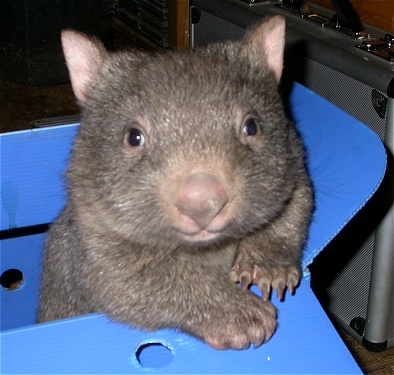Behold, the Mighty Marsupial
I can't explain why exactly I'm fascinated by wombats,
and maybe that's for the best. There are three living species
of wombat: the Common Wombat (Vombatus ursinus), the
Southern Hairy-Nosed Wombat (Lasiorhinus latifrons),
and the endangered Northern Hairy-Nosed Wombat
(Lasiorhinus krefftii).
| 
|
The Uncommon Common Wombat
The common wombat is a marsupial and the largest
burrowing herbivorous mammal on Earth. There are three
subspecies of common wombat: Vombatus ursinus hirsutus
found on the mainland, Vombatus ursinus tasmaniensis
found in Tasmania, and Vombatus ursinus ursinus once
found throughout the Bass Strait islands but now restricted to
Flinders Island.
The common wombat is a large animal, averaging over a meter in length. They're dense and squat, sometimes weighing as much as 35kg. Their thick fur ranges in colour from sandy brown to grey and black. They use their short legs, large paws and long claws to scramble around on the surface and to excavate their burrows.
Wombats are mostly nocturnal, but during the winter they may sometimes be seen about during the day. They graze for between three and eight hours a night, traveling extensively and visiting up to four burrows within their home range to rest or tidy up the burrow.
Wombats are solitary creatures, with only one inhabiting any given burrow. The overlap of home ranges does occasionally result in a number of wombats using the same burrow.

An inquisitive juvenile Common Wombat in what appears to be a cat carrier
The Southern Hairy-Nosed Wombat
The Hairy-Nosed Wombats are somewhat smaller, but similar in most other respects, to their cousins the Common Wombat. They have longer, pointed ears, a hairy muzzle, and soft, silky fur. The Southern Hairy-Nosed Wombat inhabits semi-desert and scrublands, and their bodies have evolved various methods of retaining what little moisture their diet provides.
Hairy-Nosed Wombats also tend to be more social than their cousins, often inhabiting vast warrens.
The Northern Hairy-Nosed Wombat
There are less than a hundred Northern Hairy-Nosed Wombats remaining in the wild, and none have survived in captivity. This extremely endangered species can only be found in Epping Forest National Park, in a series of warrens and adjoining grazing land totalling less than 300 hectares.
Attempts are being made to preserve this species, and their numbers have increased from a recorded low of 65 in 1993.
| 